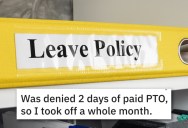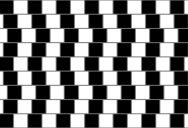This is the Cafe Wall Illusion
by twistedsifter

The café wall illusion is a geometrical-optical illusion in which the parallel straight dividing lines between staggered rows with alternating black and white “bricks” appear to be sloped. [Graphic above by Fibonacci]
Reported by Richard Gregory and Priscilla Heard in 1979, Gregory recalls:
It was noted some time ago (Gregory 1973) by a then member of our laboratory, Steve Simpson, that the mortar lines of the chessboard-like design of tiles of a café wall in St Michael’s Hill, near our laboratory in Bristol, appear not parallel as they are, but to converge markedly in alternate-direction wedges.

Photograph by Steven Battle
You can find Gregory’s original paper in its entirety on richardgregory.org. You can also find a PDF of the paper on his website here. It gets pretty technical but you can read the paper’s abstract below.
Before you get to the abstract though, check out the illusion in action below. The images were posted to reddit this past weekend by thegoldenmandenis who recreated the effect when putting up tiles in his home. Note how the illusion ‘disappears’ after he grouts the tiles.



Border locking and the Café Wall illusion, 1979
Richard L Gregory, Priscilla Heard
[Abstract] The Cafe Wall illusion (seen on the tiles of a local café) is a Münsterberg checkerboard figure, but with horizontal parallel lines which may have any luminance separating the rows of displaced squares. These (these ‘mortar’ lines) display marked wedge distortion which is especially affected by: contrast of the squares (’tiles’; width of the ‘mortar’ lines, and their luminance which must not be significantly higher than that of the light squares or lower than that of the dark squares for distortion to occur. An experiment is described from which quantitative data have been obtained by varying these parameters. It is suggested that contiguous regions of different luminance (and contiguous colour regions) are normally held in spatial register by locking from common luminance boundaries. The Café Wall illusion is attributed to this border locking producing inappropriate contour shifts from neighbouring regions of contrasting luminance when separated by narrow gaps of neutral luminance. Further implications on the border-locking notion are discussed. [source]

Seen above is the Port 1010 building in the Docklands region of Melbourne, Australia whose exterior facade shows the café wall illusion in full effect.
If you enjoyed this post, the Sifter
highly recommends:
Trending on TwistedSifter

Parents Emotionally Manipulated Grandparent Into Babysitting For 5 Days, So They Took The Kids To Disney Without The Parents



